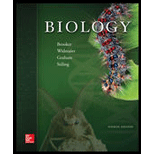
Biology
4th Edition
ISBN: 9781259188121
Author: Peter Stiling, Robert Brooker, Linda Graham, Eric Widmaier
Publisher: McGraw-Hill Education
expand_more
expand_more
format_list_bulleted
Concept explainers
Question
Chapter 48.2, Problem 1BC
Summary Introduction
To determine: The relation of countercurrent exchange with the heat exchange in vertebrates.
Introduction: The process of circulation inside the body of an organism is responsible for the transportation of oxygen and various nutrients. The purpose of circulation is to fulfill the demands of the tissues and organs and maintain the internal environment of the body.
Expert Solution & Answer
Want to see the full answer?
Check out a sample textbook solution
Students have asked these similar questions
✓ Details
Draw a protein that is embedded in a membrane (a transmembrane protein), label the lipid bilayer and the protein. Identify the areas of
the lipid bilayer that are hydrophobic and hydrophilic.
Draw a membrane with two transporters: a proton pump transporter that uses ATP to generate a proton gradient, and a second
transporter that moves glucose by secondary active transport (cartoon-like is ok). It will be important to show protons moving in the
correct direction, and that the transporter that is powered by secondary active transport is logically related to the proton pump.
drawing chemical structure of ATP. please draw in and label whats asked. Thank you.
Outline the negative feedback loop that allows us to maintain a healthy water concentration in our blood.
You may use diagram if you wish
Chapter 48 Solutions
Biology
Ch. 48.1 - Prob. 1CCCh. 48.2 - Prob. 1CCCh. 48.2 - Prob. 2CCCh. 48.2 - Prob. 1BCCh. 48.2 - Prob. 3CCCh. 48.3 - Prob. 1CCCh. 48.3 - Prob. 2CCCh. 48.3 - Prob. 1EQCh. 48.3 - Prob. 2EQCh. 48.3 - Prob. 3EQ
Ch. 48.4 - Prob. 1CCCh. 48.4 - Prob. 2CCCh. 48.5 - Prob. 1BCCh. 48.7 - Can you think of an analogy to bronchodilation and...Ch. 48 - Prob. 1TYCh. 48 - Prob. 2TYCh. 48 - The process of bringing oxygenated water or air...Ch. 48 - Prob. 4TYCh. 48 - The countercurrent exchange mechanism in fish...Ch. 48 - The tracheal system of insects a. consists of...Ch. 48 - Prob. 7TYCh. 48 - Prob. 8TYCh. 48 - Prob. 9TYCh. 48 - Prob. 10TYCh. 48 - Prob. 1CQCh. 48 - Prob. 2CQCh. 48 - Prob. 3CQCh. 48 - Prob. 1COQCh. 48 - List the components of the mammalian respiratory...
Knowledge Booster
Learn more about
Need a deep-dive on the concept behind this application? Look no further. Learn more about this topic, biology and related others by exploring similar questions and additional content below.Similar questions
- Give examples of fat soluble and non-fat soluble hormonesarrow_forwardJust click view full document and register so you can see the whole document. how do i access this. following from the previous question; https://www.bartleby.com/questions-and-answers/hi-hi-with-this-unit-assessment-psy4406-tp4-report-assessment-material-case-stydu-ms-alecia-moore.-o/5e09906a-5101-4297-a8f7-49449b0bb5a7. on Google this image comes up and i have signed/ payed for the service and unable to access the full document. are you able to copy and past to this response. please see the screenshot from google page. unfortunality its not allowing me attch the image can you please show me the mathmetic calculation/ workout for the reult sectionarrow_forwardIn tabular form, differentiate between reversible and irreversible cell injury.arrow_forward
- 1.)What cross will result in half homozygous dominant offspring and half heterozygous offspring? 2.) What cross will result in all heterozygous offspring?arrow_forward1.Steroids like testosterone and estrogen are nonpolar and large (~18 carbons). Steroids diffuse through membranes without transporters. Compare and contrast the remaining substances and circle the three substances that can diffuse through a membrane the fastest, without a transporter. Put a square around the other substance that can also diffuse through a membrane (1000x slower but also without a transporter). Molecule Steroid H+ CO₂ Glucose (C6H12O6) H₂O Na+ N₂ Size (Small/Big) Big Nonpolar/Polar/ Nonpolar lonizedarrow_forwardwhat are the answer from the bookarrow_forward
- what is lung cancer why plants removes liquid water intead water vapoursarrow_forward*Example 2: Tracing the path of an autosomal dominant trait Trait: Neurofibromatosis Forms of the trait: The dominant form is neurofibromatosis, caused by the production of an abnormal form of the protein neurofibromin. Affected individuals show spots of abnormal skin pigmentation and non-cancerous tumors that can interfere with the nervous system and cause blindness. Some tumors can convert to a cancerous form. i The recessive form is a normal protein - in other words, no neurofibromatosis.moovi A typical pedigree for a family that carries neurofibromatosis is shown below. Note that carriers are not indicated with half-colored shapes in this chart. Use the letter "N" to indicate the dominant neurofibromatosis allele, and the letter "n" for the normal allele. Nn nn nn 2 nn Nn A 3 N-arrow_forwardI want to be a super nutrition guy what u guys like recommend mearrow_forward
arrow_back_ios
SEE MORE QUESTIONS
arrow_forward_ios
Recommended textbooks for you
- Nutritional Sciences: From Fundamentals to Food, ...Health & NutritionISBN:9781337486415Author:McGuirePublisher:Cengage
 Human Physiology: From Cells to Systems (MindTap ...BiologyISBN:9781285866932Author:Lauralee SherwoodPublisher:Cengage Learning
Human Physiology: From Cells to Systems (MindTap ...BiologyISBN:9781285866932Author:Lauralee SherwoodPublisher:Cengage Learning Biology: The Dynamic Science (MindTap Course List)BiologyISBN:9781305389892Author:Peter J. Russell, Paul E. Hertz, Beverly McMillanPublisher:Cengage Learning
Biology: The Dynamic Science (MindTap Course List)BiologyISBN:9781305389892Author:Peter J. Russell, Paul E. Hertz, Beverly McMillanPublisher:Cengage Learning  Biology (MindTap Course List)BiologyISBN:9781337392938Author:Eldra Solomon, Charles Martin, Diana W. Martin, Linda R. BergPublisher:Cengage LearningLifetime Physical Fitness & WellnessHealth & NutritionISBN:9781337677509Author:HOEGERPublisher:Cengage
Biology (MindTap Course List)BiologyISBN:9781337392938Author:Eldra Solomon, Charles Martin, Diana W. Martin, Linda R. BergPublisher:Cengage LearningLifetime Physical Fitness & WellnessHealth & NutritionISBN:9781337677509Author:HOEGERPublisher:Cengage

Nutritional Sciences: From Fundamentals to Food, ...
Health & Nutrition
ISBN:9781337486415
Author:McGuire
Publisher:Cengage

Human Physiology: From Cells to Systems (MindTap ...
Biology
ISBN:9781285866932
Author:Lauralee Sherwood
Publisher:Cengage Learning

Biology: The Dynamic Science (MindTap Course List)
Biology
ISBN:9781305389892
Author:Peter J. Russell, Paul E. Hertz, Beverly McMillan
Publisher:Cengage Learning

Biology (MindTap Course List)
Biology
ISBN:9781337392938
Author:Eldra Solomon, Charles Martin, Diana W. Martin, Linda R. Berg
Publisher:Cengage Learning

Lifetime Physical Fitness & Wellness
Health & Nutrition
ISBN:9781337677509
Author:HOEGER
Publisher:Cengage

What is Homeostasis? | Physiology | Biology | FuseSchool; Author: FuseSchool - Global Education;https://www.youtube.com/watch?v=quQr6X1Q58I;License: CC-BY